We provide a variety of comprehensive services to fit your needs. See a complete list of our services and additional information below.
Emergency Dental Care

Dental emergencies can come about in any number of ways. Your discomfort may be due to an injury to the oral facial area, the acute flare up of a longstanding problem, or the result of the sudden onset of seemingly inexplicable pain. Whatever the case may be, urgent dental care is needed to provide you with relief and to avoid any further consequences to your oral health or function, as well as your overall well being.
There are many reasons to seek emergency dental care, including severe toothaches, chipped or fractured teeth, a dental abscess, impacted teeth, loose or broken fillings, lost or dislodged crowns, broken dentures and more. While the pain of a toothache is one of the more common reasons that patients come to our dental office for emergency dental care, we also promptly treat emergencies that are not necessarily painful like crowns that have been dislodged and broken dentures that leave embarrassing gaps in one’s smile.
Whether your dental emergency is painful, if it affects the appearance of your smile, or if you suspect that an infection is present, contact our office immediately for care. We will make every effort to see you as promptly as possible.
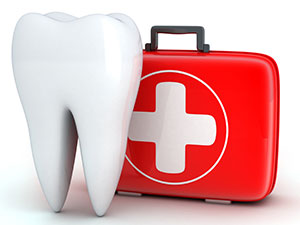
Toothaches
A toothache is the most common reason for oral pain. It is an uncomfortable, distressing and debilitating situation that if left untreated can result in serious consequences to an individual’s oral health as well as overall well-being. Depending upon the underlying cause of a toothache and the degree of damage to the tooth and involvement of the surrounding tissues, the type and severity of symptoms can vary. While mild symptoms of discomfort are easy to dismiss and ignore, waiting until toothache pain is more consistent or severe is not advised. The best option is to make a timely appointment with the dentist for a professional assessment and care.
Although the reason for most toothaches is cavities (tooth decay/dental caries), a toothache or what may feel like pain related to the teeth can be due to any number of underlying conditions including:
- A Cavity
- Dentin Hypersensitivity (Sensitive teeth)
- Dental Trauma resulting in chips, fractures, cracks or nerve damage to the tooth
- Infection or Abscess
- Periodontal Disease (Gum Disease)
- Bruxism
- Erupting or Impacted Teeth (wisdom teeth are often problematic)
- Sinus or Ear Infections
- Other medical conditions with referred pain to the jaw
Different types and degrees of toothache pain can point to different underlying causes and help in the diagnosis of the problem. Sharp and stabbing pain when eating or drinking hot and cold foods may be due to the presence of a cavity or exposed dentin and sensitive teeth. Pain with pressure or biting down may indicate a cavity or even a broken filling, a cracked tooth or periodontal problem. If the pain is continuous or throbbing, it is a sign that tooth decay or trauma has affected the nerve of a tooth or that an infection requiring prompt care is present. Localized swelling around the tooth or more generalized tissue and facial swelling and fever must be taken care of as quickly as possible.
Treatment of a toothache depends upon the diagnosis of the underlying problem, the degree of damage to the involved tooth or surrounding tissues and if any infection is present. Once the dentist has performed a comprehensive evaluation of the case, the appropriate recommendations and care to alleviate the symptoms and restore oral health will be provided.
Traumatic Injuries
Traumatic oral injuries can range from dental injuries to the teeth and their supporting tissues to lacerations in and around the mouth as well as more complex and severe damage to the soft tissues and bones of the face. These injuries are often caused by direct physical trauma to the teeth, mouth and face that may be the result of a fall, sports or work related incidents, motor vehicle accidents or assaults.
Chipped, Fractured or Cracked Teeth
It is not uncommon for a tooth to sustain a chip, crack or fracture. It may happen simply from biting down on a piece of ice, chewing on a pencil, or sustaining trauma such as a direct blow to the face and mouth. The damage to a tooth can range from a minor craze line or a small chip of the dental enamel to a more extensive fracture of the tooth that can even go so far as to fracture the root or split the tooth. Based upon the extent of damage to the fractured or cracked tooth, treatment may simply involve placing a suitable restoration such as a filling or crown or a root canal procedure along with a restoration. When the damage is extensive, an extraction is sometimes required.
Dentoalveolar Injury
Dentoalveolar injuries refer to traumatic injuries involving the teeth and the bone surrounding the teeth. These injuries can include teeth that have been dislodged or moved partially out of their sockets, with or without a segment of the adjacent bone, or an avulsion, which means that a tooth has been completely “knocked out” of its socket. In these situations, immediate dental care to reposition and stabilize the involved teeth and/or put the bone back into the correct anatomical positions is required. Beyond the routine post op care to check for tissue healing, the involved teeth are typically followed for a longer period of time to check for subsequent nerve involvement or other issues that may require additional care.
Soft Tissue Injuries
Soft tissue injuries in and around the oral cavity include lacerations within the mouth (intra-oral) and facial lacerations. If possible clean the area gently with water and apply a cold compress. For puncture wounds, tissue tears, and lacerations to the lips, cheeks, tongue or any other tissues in and around the oral cavity, prompt emergency care is required.
Dislocated or Fractured Jaw
Facial trauma that has resulted in a suspected dislocation or jaw fracture requires immediate care as problems with eating and breathing can ensue. Prompt care can minimize complications and accelerate healing. For a fractured jaw, treatment depends upon the extent of the injuries. While some clean breaks may only require immobilization, multiple fractures of the jawbone or displaced breaks involve more complex surgical care. If on the other hand the jaw has been dislocated as a result of a traumatic incident or opening the mouth too widely, it will need to be manipulated back into the correct position. For people who have had more than one dislocation, surgery may be needed to reduce the risk of further dislocations.
Dental Implants

Dental implants represent the most recent and advanced method of replacing lost or missing teeth. Invented in 1952 by a Swedish surgeon named Per-Ingevar Branemark, dental implants today offer a highly effective, long-term solution for replacing missing teeth to reestablish a fully functional and attractive smile. Dental implants can be used to replace a single tooth, multiple teeth or all of the upper and/or lower teeth.
A dental implant is a small, biocompatible post that is surgically positioned by means of a minimally invasive procedure into the jawbone beneath the gums. Once healing takes place and the implant integrates with the bone, it behaves in much the same way as the root of a natural tooth to provide support for an aesthetically appealing dental crown or bridge. A period ranging from 3 to 6 months is required for the jawbone to fuse with the implant via a process known as osseointegration.
What are the benefits of replacing lost or missing teeth with dental implants?
Dental implants offer several advantages over traditional methods of tooth replacement including:
- Dental implants come the closest to replicating the look, feel, and function of natural teeth.
- With precise placement, good oral hygiene and routine care, dental implants can last for many years.
- Dental implants provide continued stimulation to the underlying bone to prevent the bone loss that occurs when teeth are missing to preserve natural facial contours.
- Since implants behave like natural teeth, there is no chance that they will slip or dislodge like removable dentures when speaking or eating.
- With dental implants, it is possible to speak with ease as well as eat and taste all types of food with virtually no restrictions.
- Dental implants do not decay and will not develop cavities.
- Unlike a fixed bridge, dental implants do not require any preparation or crowning of teeth adjacent to the edentulous area.
Who is a candidate for a dental implant procedure?
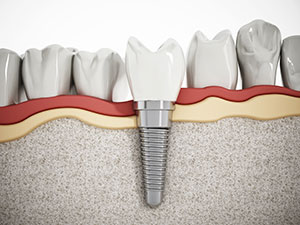
According to clinical studies, dental implants have a demonstrated long-term success rate of well over 95%. One key to the success and longevity of a dental implant is that sufficient bone is present to provide stable support for the implanted surgical post. If insufficient bone is present, a bone grafting procedure is often recommended prior to the placement of a dental implant. Additionally, candidates for dental implants should be free of periodontal disease and be aware that a continued, effective oral hygiene routine and care is necessary to maintain a strong and functional implant.
Treatment Planning for Dental Implants
Treatment planning a patient for the precise placement of a dental implant involves advanced scanning technology and software to map out the details of care from both a prosthetic and surgical prospective. In this way a case can be planned and meticulously executed from the beginning with the final restoration in mind. With advances in implant dentistry multiple approaches to care are now being offered. In certain cases an implant can be placed at the same time a dental extraction is performed. This procedure is known as, "immediate dental implant placement." Additionally, it is also sometimes possible to place "same-day dental implants." With this procedure a temporary crown or bridge can be attached to the implants at the same time they are placed. In all cases, complete healing and osseointegration is required before the placement of the final prosthesis.
Types of Dental Implants
Most dental implants are made of titanium but are also available "metal-free" zirconia. Both titanium and zirconia are biocompatible materials, which integrate well with the hard and soft tissues in the jaw. Depending upon the requirements of the case, a single dental implant can be restored with a crown to replace one missing tooth, or multiple implants can be used to support a fixed bridge. In cases where all of the upper and/or lower teeth are missing a full-arch, implanted supported bridge can be placed. Special implants can also be placed for added support and stability for removable overdentures or as anchorage devices in orthodontics called "TAD's" or Transitional Anchorage Devices.
CT Scan
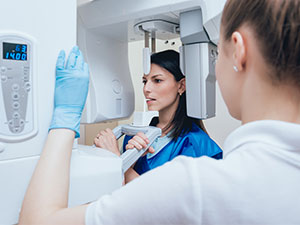
Achieving successful treatment outcomes relies upon using the best diagnostic technology to develop the most appropriate plans of care. A CT scan is one of the most advanced and multifunctional radiographic technology products available today.
With this versatile, and high tech system, multiple types of two and three-dimensional images to facilitate the most precise and effective care can be obtained. High-resolution radiographs of the teeth provide the dentist with the best means to accurately assess orofacial health and development as well as to formulate the most effective treatment plans for a full range of procedures.
An exceptionally designed and engineered system, a CT scan offers the shortest scan time and can very comfortably obtain distortion-free images from a number of angles with the lowest radiation exposure to the patient.
Bone Grafting

Bone loss in the jaws and around the teeth can be the result of missing teeth, periodontal disease, or trauma. This bone loss is more than a detriment to oral health and function; it can also alter facial appearance as the support for the natural contours of the face is diminished.
When a tooth is extracted, the natural stimulation to the underlying bone that is generated by the forces of biting or chewing is lost. The fact of the matter is that bone width can be reduced by as much as 25% in the first year following tooth loss.
By performing grafting procedures, we can help restore the bone to its original dimensions to maintain facial esthetics, repair the damage caused by periodontal disease as well as facilitate the success of procedures such as the placement of dental implants. A bone graft provides a platform or “scaffolding” for new bone growth and the material for a bone graft can be derived from the patient, other donor sources or be comprised of synthetic, bone-like materials.
Several types of grafting procedures are performed depending upon the particular needs of the case.
A bone graft can be placed immediately upon the extraction of a tooth or some time after tooth loss. Placing a bone graft at the time of tooth removal reduces the amount of bone loss in the area to maintain the hard tissue support that is required for the future placement of a dental implant. When a bone graft is placed awhile after tooth loss, a separate surgical procedure is required to reflect the soft tissue, expose the underlying bone, place a graft and then suture the soft tissue back into place.
For patients lacking a sufficient amount of bone for a dental implant to replace a maxillary back tooth (upper back tooth), a procedure, which is known as a “sinus lift” is performed. During this surgical procedure, the sinus membrane is lifted, and bone graft material is added between the jaw and the floor of the sinus to provide the needed bone height to support a dental implant successfully.
In addition to bone grafting for purposes of ridge preservation or augmentation to allow for dental implants, an aesthetic ridge augmentation procedure to restore the natural contours of the bone is sometimes performed in preparation for fixed bridgework to achieve a more cosmetically pleasing result.
To guide tissue regeneration as well as protect the graft and promote healing, we may place specialized membranes and biologically active materials over the grafting material.
Sinus Lift

For patients lacking a sufficient amount of bone for a dental implant to replace a maxillary back tooth (upper back tooth), a procedure known as a “sinus lift” may be performed. During this surgical procedure, the sinus membrane is lifted and bone graft material is added between the jaw and the floor of the sinus to provide the needed bone height to successfully support a dental implant.
Teeth in a Day

Today, with the use of state-of-the-art surgical techniques it is possible in select cases to place dental implants that are ready for “same day” restoration with natural looking temporary teeth. This approach not only offers significant cosmetic benefits, it eliminates the need for a second minor surgical procedure to uncover the dental implants for the placement of the permanent crowns. Once the dental implant is fully integrated with your natural bone, which is typically within three to six months of implant placement, the initial temporary crown can be readily replaced with a fully functional and beautiful permanent crown.
All-on-4®

This remarkable technique requires only 4 implants in either the upper or lower jaw to support all the replacement teeth for that dental arch. All-on-4®* typically involves only one surgery to place all the implants, avoids the need for additional bone grafting procedures, and provides the instant gratification of receiving a full set of temporary teeth immediately on the same day as the initial procedure. As a permanent fixed replacement for all the teeth, the All-on-4 dental implant technique achieves unprecedented results with a minimal number of dental implants and surgical procedures, thereby making it an appealing cost-effective solution for permanently replacing a full set of teeth. Once post-surgical healing is complete and the All-on-4 dental implants have fully integrated with your jawbone, the temporary bridge is permanently replaced by your customized final bridge. These new permanent replacement teeth are completely secure and stable and function in a similar fashion as natural teeth.
*All-on-4 is a registered trademark of Nobel Biocare
All-on-6
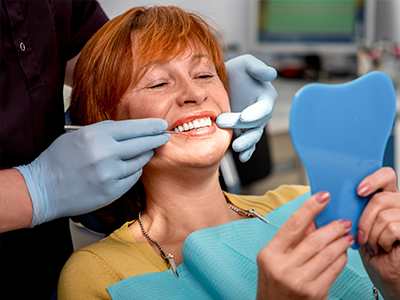
A high-tech alternative to traditional dentures, the All-on-6 technique creates a comfortable and stable full set of upper and/or lower teeth using six strategically placed specialized dental implants. While conventional removable dentures can effectively replace a full complement of lost or missing teeth, All-on-6 dental implants provide a fixed and permanent method of reestablishing a complete set of teeth. This restores patients with a sense of having their own teeth and offers an improved quality of life as they can once again eat and speak with confidence. With ALL-On-6 dental implants the need for messy denture adhesives or having to take one’s dentures out to clean and sanitize them is eliminated. The replacement teeth are cared for in very much the same way as a set of natural teeth.
All-On-6 dental implants offer a less invasive and quicker way to restore a full upper or lower set of teeth than treatment with conventional dental implants. Requiring just six implants per jaw for a complete set of functional teeth, All-on-6 treatment may reduce the need for preliminary bone grafting surgery. Utilizing the All-on-6 method, temporary teeth can often be placed right away with a permanent set to follow within just a few months after the implants become fully integrated with the surrounding bone.
Zygomatic Implants

When the quality and quantity of bone in the upper jaw is insufficient for the successful placement of conventional dental implants, zygomatic dental implants provide the required stability and support to rebuild a complete smile with implant-supported crowns, bridges, and other dental prostheses.
With zygomatic dental implants, there’s no need to perform additional surgical procedures such as bone grafting or sinus lift procedures to increase the volume of bone required for successful implant placement. What this means is that patients, who are not candidates for bone augmentation or sinus lifts, can still enjoy the benefits of an implant-based solution to reestablish their smiles.
While conventional dental implants are placed directly into the jawbone, zygomatic dental implants are placed in the zygomatic bone, which is more commonly known as the cheekbone. Located on the left and right side of the upper jaw, the cheekbones have the inherent strength and density to provide ample support for zygomatic dental implants, which once placed are immediately stable enough to support restorations.
Mini Dental Implants

One of the dental solutions available for the treatment of multiple lost or missing is a removable denture. While a removable denture is an effective prosthetic appliance for restoring one’s smile, there can be issues with stability that affects the comfort and function of the denture. However, there is a way to effectively address these problems with the placement of mini dental implants.
Mini dental implants are narrower in diameter than traditional dental implants. This makes them an excellent option for providing added denture stability in cases where a grafting procedure to create enough bone volume for the placement of full size implants would otherwise be needed. Furthermore, mini implants can be placed in a less invasive manner, making them an easier procedure to tolerate for people with certain medical conditions.
An implant-supported denture is fitted with special housings that allow the denture to essentially snap on to the head of the mini implant to provide the needed denture stabilization.
Wisdom Teeth Removal

Wisdom teeth, which are also known as the third molars, are the last permanent teeth to develop in the oral cavity as well as the final ones to come into place. However, as is often the case, many wisdom teeth do not have sufficient room to erupt, are not developing properly, or are causing issues for the adjacent teeth and the surrounding tissues. We frequently see patients with impacted or problematic wisdom teeth for an evaluation or extractions as indicated.
A wisdom tooth is considered impacted when it is submerged under gum tissue or bone and unable to erupt into position. Based on the type and amount of overlying tissue, impactions are classified in a few different ways. Soft tissue impactions occur when a wisdom tooth remains covered by gum tissue. If a wisdom tooth remains completely, or partially obstructed by bone, it's known as a bony impaction.
Impacted wisdom teeth can potentially cause many problems and may need to be removed when they are the source of:
• Pain
• Infection
• Cysts
• Tumors
• Damage to adjacent teeth
• Gum disease
• Extensive tooth decay
Although the extraction of wisdom may be recommended for older patients, the early removal of problematic or potentially problematic wisdom teeth in young adults is often the case. Among the many reasons for this approach to care is that extractions at this stage of life are simpler, and patients experience a shorter recovery time with fewer complications.
Whatever the case may be, patients of all ages can rely on our expertise for the evaluation and treatment recommendations for developing, impacted, or erupted wisdom teeth.
Sedation Dentistry

Sedation dentistry offers individuals with general anxiety about going to the dentist or fears about a specific dental procedure the opportunity to have a stress free and more comfortable experience. Utilizing safe and controlled sedation techniques prior to the dental procedure the patient is eased into a state of complete relaxation. This eliminates any discomfort, pain, and preoperative anxiety that may be associated with a particular dental visit. With sedation dentistry patients typically feel more at ease post-operatively as they have little or no memory of the actual moment-to-moment dental procedure.
Nitrous Oxide
Commonly referred to as “laughing gas,” nitrous oxide is used as a mild sedative to reduce anxiety and allow a level of relaxation during a procedure. Nitrous oxide is inhaled through a small mask over the nose. It is administered for the duration of the procedure and is turned off as the procedure is coming to an end. The effects of this method of sedation wear off very quickly.
Oral Sedation
Oral Sedation means that you will be given a prescription for an oral medication prior to you appointment. Taken at the recommended time before your appointment, this medication allows you to fully relax by the time your procedure begins. When receiving oral sedation, a patient must have an escort on the day of the procedure to drive them to and from the office.
Snap-On Smile®
Snap-On Smile® is a fully customizable set of attractive, natural-looking teeth developed of high-tech dental resin that is designed to fit easily over your existing teeth. Available for both your upper and lower front teeth, Snap-On-Smile is a highly effective yet affordable cosmetic solution to mask unsightly gaps, stains, or dental imperfections as well as crooked or missing teeth. As a temporary or provisional long-term solution for improving the appearance of an imperfect smile, it is an ideal option for patients who cannot afford the expense or make the commitment to more permanent treatment methods of care such as dental crowns, bridges or implants.
Getting your fully customizable Snap-On Smile involves a painless and non-invasive process that requires no drilling, injections, or change in the structure of your teeth. Best of all, it only requires two short visits to take an impression and to provide you with a final fitting of your new Snap-On Smile.
The cosmetic effect is instantaneous, giving you a bright and beautiful smile with a snap! A Snap-On Smile leaves you free to eat, drink, and speak in close to the same way you would with a natural set front teeth. Your provisional smile is easy to care for and works well for both temporary and longer-term use.
Lumineers®
Lumineers® are custom designed to transform any smile
- Whiten stained teeth
- Reshape misaligned/awkward/crooked teeth
- Correct uneven teeth
- Lengthen short teeth
- Close spaces
- Revitalize old crowns and bridgework
- Fix chipped teeth
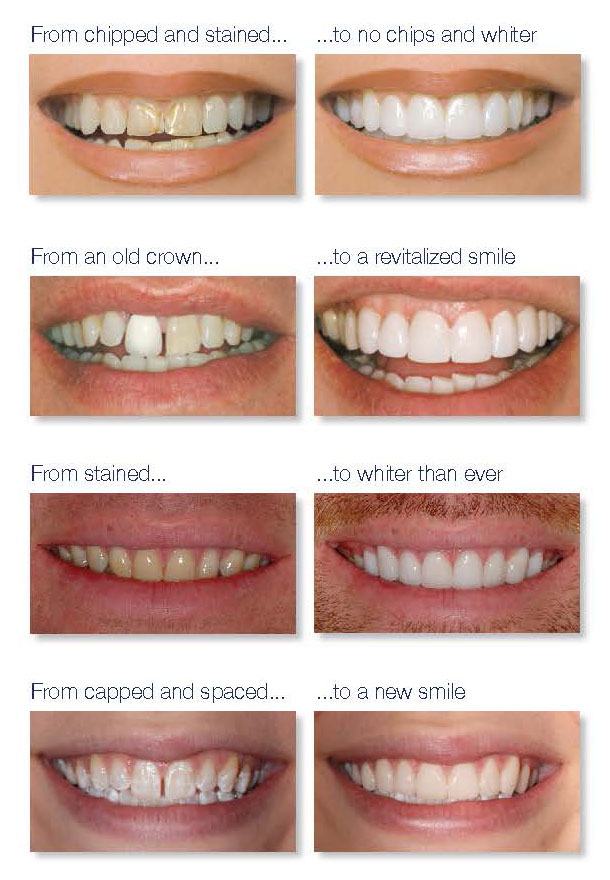
You can have a permanently white, perfect smile in only 2 visits.
No other treatment comes close.
By using a highly advanced technique, Lumineers
can be placed in just 2 easy visits without requiring
shots or drilling of your sensitive tooth structure.*
Made from extraordinarily strong, patented
Cerinate porcelain, Lumineers
are clinically proven to
maintain their radiance
and integrity for over
20 years.** That durability
improves the strength
of your teeth.
No grinding, drilling or shots. Lumineers simply adhere to your natural teeth.
There’s simply no substitute for a Lumineers smile! That’s why you should ask your dentist for Lumineers by name. Unlike traditional veneers, Lumineers preserve your tooth structure and require no shots or drilling.* Because your own teeth are preserved, Lumineers are completely reversible. With quick and painless Lumineers, you have nothing to lose... and a beautiful smile to gain.
- No shots, no drilling of sensitive tooth structure*
- 2 easy dentist visits*
- Clinically proven to last over 20 years**
- Instant whitening that lasts
- Extraordinarily strong
- No sensitivity afterwards
- No uncomfortable temporaries
- Completely reversible*
*Tooth contouring may be necessary. Individual cases may vary.
**Data on file.



